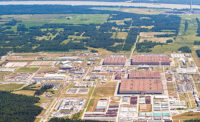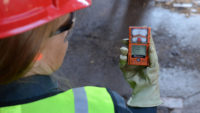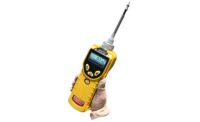Wireless gas monitoring predicts safety risks

To reduce risks, wireless remote gas monitoring is rapidly gaining ground. Monitoring gas levels in real-time identifies tank leaks and dangerous confined-space gas levels. Data such as the time of reading, concentrations, lower explosive limits, and other variables may be analyzed and trended to identify dangerous situations and ultimately predict failure before it occurs.
Wireless systems can now integrate dedicated wireless monitors, personal protection monitors, GPS data, real-time meteorological data and personal physiologic data.
Detection and data capture expedite and accelerate decision making, and improve planning and forecasting for safety and maintenance purposes. Wireless gas monitors rebroadcast alarms and data in real-time using mobile devices and the Internet. Wireless hazard detection system users can now engage remote experts in the same way that doctors working in remote locations can interface with medical center specialists in real time.
Using “Big Data”
Data access has now become an operational advantage. Today, wireless gas detection monitors allow data to be detected, transmitted, logged, archived, and extrapolated. Algorithms and computing models are emerging to accurately project trends, predict events, and identify risk, driving engineering decisions to assess and control risks. Detection and data logging allow data to stream into a central location with dashboards and indicators to predict maintenance intervals, downtime duration, and equipment and system failure.
With the advent of big data and its computation, software can be programmed to answer critical safety and maintenance questions:
- What are/were the levels when a tank was last entered?
- How much water washing was required to reduce gaseous levels before entry?
- Did workers need to vacate a space or confinement during the last entry due to high levels of oxygen, hydrogen sulfide, ammonia, or VOCs?
- Why was a worker out sick the day after he entered a tank vessel used in a chemical process?
- What steps and processes can be used to better plan maintenance and improve worker safety?
Aggregated data, combined with real-time plant-wide gas detection information, allows you to better invest maintenance resources to manage the next downtime event. This increases reliability and ultimately boosts productivity. It is a maintenance and safety best practice.
Operational improvements
Software computes the data from wireless gas detectors and correlates it with other variables such as downtime, worker output, maintenance costs, and production schedules, helping drive management decisions to best allocate resources. Software transforms the interpolation of such data into useful information and mitigates operational, engineering, and safety risk by using predictive analysis to drive decisions.
For example, knowing when and how gas levels increase can be determined by the data logged by the wireless monitors. This may dictate, with predictable accuracy, how often a tank or pressure vessel must be accessed and how to train personnel to safely enter and exit the tank.
It may also be linked to plant equipment downtime, indicating process flaws where portable detection equipment was unreliable.
An increasing change in particle detection or parts-per-million concentration of a particular substance may easily support a trend analysis, indicating where and when corrective action could and should be taken.
Controlling downtime
Pacific Ethanol’s Boardman, Oregon, facility has a fixed gas monitoring system, as well as portable monitors to wirelessly transmit data to a central location, where software logs gas levels of oxygen, hydrogen sulfide, carbon monoxide, and ammonia from each monitor. The accuracy of the monitors and the wireless monitoring capability helps facility managers use historical data and real-time gas levels to control plant downtime for enhanced safety and efficiency.
“We typically have a 24-hour downtime every time we do maintenance,” says Lyndon Jones, plant manager of Pacific Ethanol’s plant in Boardman. These downtimes may occur as frequently as every six weeks and require gas-freeing tanks and process vessels prior to manned entry. While a person enters the tank, levels are carefully monitored to ensure that gas levels are not dangerously high.
In addition, Pacific Ethanol managers now look back to their last maintenance downtime for a tank. To reduce gas levels in a particular vessel, maintenance crews need to water wash and flush the tank prior to entry. With a record of last flushing and levels, they are able to target the degree of flushing required.
Jones explains how data logging gas levels help Pacific Ethanol manage unplanned maintenance. When an agitator in one of their units had a damaged impeller, maintenance crews had to enter a tank. This required monitoring gas levels before and during entry. An agitator repair is not uncommon in an ethanol facility. Because Pacific Ethanol had accurate records of the last repair, it is able to better plan for the next agitator repair for a particular tank based on the gas levels before and during entry.
“We do these every six weeks, or 10 times a year. If we can reduce just an hour every shutdown, it can amount to as much as $100,000 per year, all because we have a good instrument,” says Jones.
Summary
Pacific Ethanol’s proactive approach to wireless gas detection with data logging might be the model for others to follow: Use gas detection data to best identify dangerous situations and predict safety risks early on.
Industrial production facilities should consider combining wireless gas detection information with production data analytics to develop useful trends that economize maintenance dollars and create operational and process control best practices.
Wireless gas detection systems, including some using mesh radio networking, are available with a broad range of options, including standard 110V/220V AC power, battery power, and solar operation/charging.
These options give plant safety and risk reduction managers a new set of tools to deploy in a range of safety management situations. Other applications for wireless gas detection include HazMat response, energy exploration and drilling, refinery turnarounds, sewage/water treatment plants, petrochemical transportation, confined space entry, rendering plant-wide detection, leak detection, worker protection, fenceline monitoring, scrubber efficiency, and hydrogen sulfide (H2S) safety.
Looking for a reprint of this article?
From high-res PDFs to custom plaques, order your copy today!








